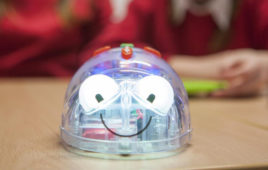A team of Caltech researchers has developed a biological toolkit of proteins that can be assembled together in different ways, like Legos, to program new behaviors in cells. As a proof-of-concept, they designed and constructed a circuit that can be added to human cells growing in a laboratory dish, detect if a cancer-causing gene is activated in the cells, and if so, cause the cells to self-destruct.
The research was done in the laboratory of Michael Elowitz, professor of biology and biological engineering and a Howard Hughes Medical Institute investigator. A paper describing the work appears in the September 21 issue of the journal Science.
Synthetic biology is the study of how to engineer cells to give them new functions, from simple tasks like blinking on and off periodically to more complex programs such as detecting and responding to disease states. Typically, this is done by editing the cell’s genome, producing a permanent modification that gets passed down when the cell replicates. A major goal in synthetic biology, according to Elowitz, is to shift this paradigm toward less genetically permanent solutions. Like using removable tape instead of super glue, the aim is to develop therapeutic “circuits” that could be administered, carry out a function, and then go away once their purpose has been served. Ideally, these would be highly targeted; instead of affecting all cells indiscriminately, the therapeutic circuits could detect when something goes wrong on the cellular level and fix it accordingly.
Now, led by postdoctoral fellow Xiaojing Gao and graduate student Lucy Chong, Caltech researchers have developed a set of protein building blocks that can be fashioned together in various combinations to produce circuits that can sense their environment and act accordingly. In the same way that electronic transistors can be wired together to create a variety of circuits, producing devices ranging from timers to computers, the components of this toolkit can be combined in different ways to produce a wide range of functions, from logical computations to signal processing, ultimately creating systems that diagnose and respond to specific cellular conditions.
As a proof of the future potential of such circuits, the team fashioned one that can, in a lab dish, detect whether a cell bears a cancerous gene and if so, destroy it. To a “normal” cell, this circuit would be harmless.
“One of the biggest challenges in biomedicine is specificity: How do you make a therapeutic that will affect only a particular type of cell? Then, how do you respond by modifying that cell in a very specific way?” says Elowitz. “These tasks are challenging for drugs, but biological circuits could excel at them. Protein circuits can be programmed to sense many types of information, process it, and respond in different ways. In fact, the reason our cells usually work as well as they do is the incredible power of our natural biological circuitry.”
“This work is simply a proof of principle and we haven’t demonstrated these functions in animals yet,” Gao says. “However, this framework could help us transition to using programmable, cell-based therapies as medicines.”
“A lot of work has been done on protein engineering, but this is the first time that we have engineered proteins that regulate—or interact with—one another in similar ways, which allows them to be combined as useful building blocks,” Chong says.



